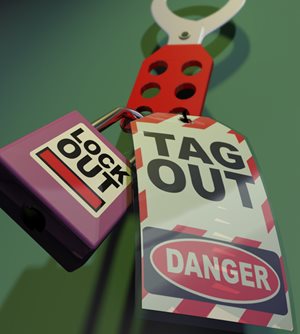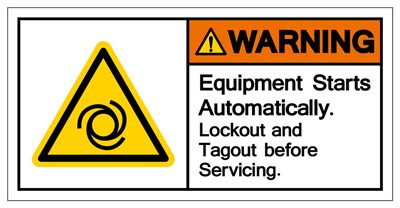Why is “lockout tagout” safety so important? In the simplest terms, it is because it is extremely hazardous for employees to work on repairing a machine when there is stored energy in it.There are three groups of employees who are impacted by lockout/tagout, including:
– Authorized employees are those who service and maintain machinery and equipment.
– Affected employees are the ones who operate machinery and equipment but do not service and maintain them.
– Other employees are those who do not service or operate equipment, but who work nearby and need to know about energy hazards and control procedures for their protection.
When Lockout Must Be Used

– Presses
– Power saws
– Conveyors
– Production equipment
– Heavy equipment
Lockout/tagout devices must be used:
– Whenever machinery or equipment is being serviced, maintained, or repaired
– When hazardous energy exists, such as electricity from a service outlet, a generator, or a battery
– Whenever unexpected start-up could occur, such as if a machine operator were to start up a machine without realizing it was being serviced by another worker
All lockout and tagout devices must be:
– Durable and capable of withstanding the environment they’re in
– Standardized by color, size, and shape so that they are more easily recognized
– Substantial enough so that they cannot be accidentally removed
– Identifiable as safety devices with a legend that uses phrases such as “Do Not Operate,” “Do Not Start,” or “Do Not Energize”
Special Situations
You will inevitably encounter special situations that may make your lockout/tagout program more difficult to administer.
Shift changes are one such situation. If servicing lasts more than one shift, lockout/tagout protection CANNOT be interrupted. Original authorized employees will remove their lock and the incoming employees will place theirs on the isolating device. If the first employee leaves before the replacement’s arrival, a supervisor may place the lock on to ensure safety. Additionally, the incoming authorized employee must verify that all energy sources are locked out before beginning work.
There are some other exceptions in the lockout/tagout process as well. For example, work can occur on a cord and plug of the equipment if it is unplugged, the plug remains within arms’ reach during servicing, and the authorized employee has exclusive control of the plug.
The other exception is if guards aren’t removed or bypassed and are effective in preventing worker exposure to hazards created by the unexpected energization or start-up of machines or equipment or the release of energy.
Additionally, many companies have equipment-specific lockout/tagout processes. Equipment-specific lockout/tagout forms must be completed by the supervisor and/or the authorized employee. All equipment-specific procedures must be easily accessible or posted directly on the equipment.
Procedures must be updated when new equipment is installed, new energy sources are added to a facility or individual equipment, the magnitude of an energy source changes, or when designated isolation points change.
For more information, visit OSHA’s Lockout/Tagout page.


